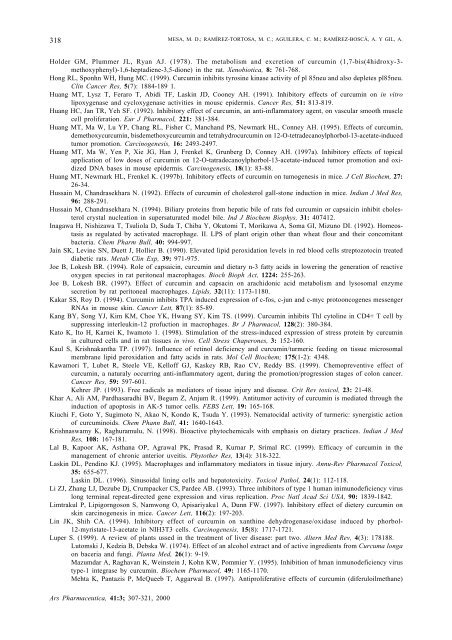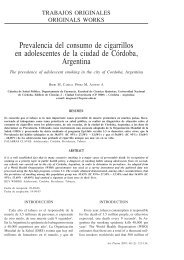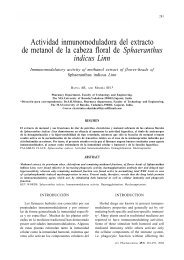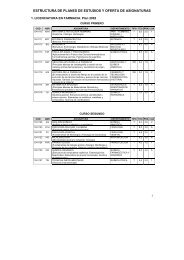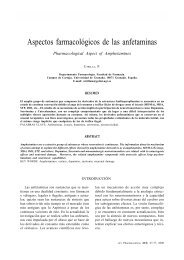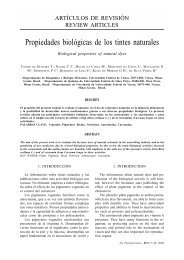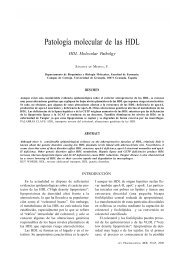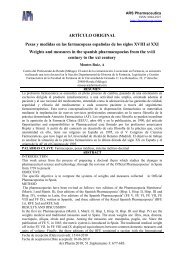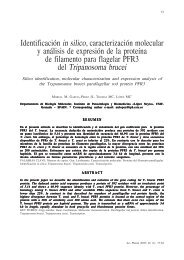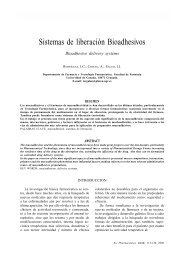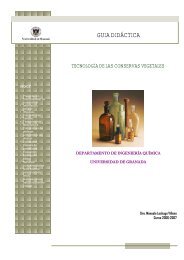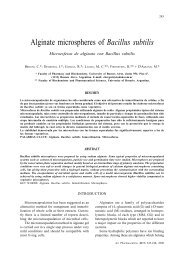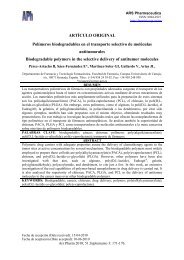Create successful ePaper yourself
Turn your PDF publications into a flip-book with our unique Google optimized e-Paper software.
318<br />
Ars Pharmaceutica, 41:3; 307-321, 2000<br />
MESA, M. D.; RAMÍREZ-TORTOSA, M. C.; AGUILERA, C. M.; RAMÍREZ-BOSCÁ, A. Y GIL, A.<br />
Holder GM, Plummer JL, Ryan AJ. (1978). The metabolism and excretion of curcumin (1,7-bis(4hidroxy-3methoxyphenyl)-1,6-heptadiene-3,5-dione)<br />
in the rat. Xenobiotica, 8: 761-768.<br />
Hong RL, Sponhn WH, Hung MC. (1999). Curcumin inhibits tyrosine kinase activity of pl 85neu and also depletes pl85neu.<br />
Clin Cancer Res, 5(7): 1884-189 1.<br />
Huang MT, Lysz T, Feraro T, Abidi TF, Laskin JD, Cooney AH. (1991). Inhibitory effects of curcumin on in vitro<br />
lipoxygenase and cycloxygenase activities in mousc epidermis. Cancer Res, 51: 813-819.<br />
Huang HC, Jan TR, Yeh SF. (1992). Inhibitory effect of curcumin, an anti-inflammatory agent, on vascular smooth muscle<br />
cell proliferation. Eur J Pharmacol, 221: 381-384.<br />
Huang MT, Ma W, Lu YP, Chang RL, Fisher C, Manchand PS, Newmark HL, Conney AH. (1995). Effects of curcumin,<br />
demethoxycurcumin, bisdemethoxycurcumin and tetrahydrocurcumin on 12-O-tetradecanoylphorbol-13-acetate-induced<br />
tumor promotion. Carcinogenesis, 16: 2493-2497.<br />
Huang MT, Ma W, Yen P, Xie JG, Han J, Frenkel K, Grunberg D, Conney AH. (1997a). Inhibitory effects of topical<br />
application of low doses of curcumin on 12-O-tatradecanoylphorbol-13-acetate-induced tumor promotion and oxidized<br />
DNA bases in mouse epidermis. Carcinogenesis, 18(1): 83-88.<br />
Huang MT, Newmark HL, Frenkel K. (1997b). Inhibitory effects of curcumin on tumogenesis in mice. J Cell Biochem, 27:<br />
26-34.<br />
Hussain M, Chandrasekhara N. (1992). Effects of curcumin of cholesterol gall-stone induction in mice. Indian J Med Res,<br />
96: 288-291.<br />
Hussain M, Chandrasekhara N. (1994). Biliary proteins from hepatic bile of rats fed curcumin or capsaicin inhibit cholesterol<br />
crystal nucleation in supersaturated model bile. Ind J Biochem Biophys, 31: 407412.<br />
Inagawa H, Nishizawa T, Tsuliola D, Suda T, Chiba Y, Okutomi T, Morikawa A, Soma GI, Mizuno DI. (1992). Homeostasis<br />
as regulated by activated macrophage. II. LPS of plant origin other than wheat flour and their concomitant<br />
bacteria. Chem Pharm Bull, 40: 994-997.<br />
Jain SK, Levine SN, Duett J, Hollier B. (1990). Elevated lipid peroxidation levels in red blood cells streptozotocin treated<br />
diabetic rats. Metab Clin Exp, 39: 971-975.<br />
Joe B, Lokesh BR. (1994). Role of capsaicin, curcumin and dietary n-3 fatty acids in lowering the generation of reactive<br />
oxygen species in rat peritoneal macrophages. Bioch Bioph Act, 1224: 255-263.<br />
Joe B, Lokesh BR. (1997). Effect of curcumin and capsacin on arachidonic acid metabolism and lysosomal enzyme<br />
secretion by rat peritoneal macrophages. Lipids, 32(11): 1173-1180.<br />
Kakar SS, Roy D. (1994). Curcumin inhibits TPA induced expression of c-fos, c-jun and c-myc protooncogenes messenger<br />
RNAs in mouse skin. Cancer Lett, 87(1): 85-89.<br />
Kang BY, Song YJ, Kim KM, Choe YK, Hwang SY, Kim TS. (1999). Curcumin inhibits Thl cytoline in CD4+ T cell by<br />
suppressing interleukin-12 profuction in macrophages. Br J Pharmacol, 128(2): 380-384.<br />
Kato K, Ito H, Karnei K, Iwamoto 1. (1998). Stimulation of the stress-induced expression of stress protein by curcumin<br />
in cultured cells and in rat tissues in vivo. Cell Stress Chaperones, 3: 152-160.<br />
Kaul S, Krishnakantha TP. (1997). Influence of retinol deficiency and curcumin/turmeric feeding on tissue microsomal<br />
membrane lipid peroxidation and fatty acids in rats. Mol Cell Biochem; 175(1-2): 4348.<br />
Kawamori T, Lubet R, Steele VE, Kelloff GJ, Kaskey RB, Rao CV, Reddy BS. (1999). Chemopreventive effect of<br />
curcumin, a naturaly occurring anti-inflammatory agent, during the promotion/progression stages of colon cancer.<br />
Cancer Res, 59: 597-601.<br />
Kehrer JP. (1993). Free radicals as mediators of tissue injury and disease. Crit Rev toxicol, 23: 21-48.<br />
Khar A, Ali AM, Pardhasaradhi BV, Begum Z, Anjum R. (1999). Antitumor activity of curcumin is mediated through the<br />
induction of apoptosis in AK-5 tumor cells. FEBS Lett, 19: 165-168.<br />
Kiuchi F, Goto Y, Sugimoto N, Akao N, Kondo K, Tsuda Y. (1993). Nematocidal activity of turmeric: synergistic action<br />
of curcuminoids. Chem Phann Bull, 41: 1640-1643.<br />
Krishnaswamy K, Raghuramulu, N. (1998). Bioactive phytochemicals with emphasis on dietary practices. Indian J Med<br />
Res, 108: 167-181.<br />
Lal B, Kapoor AK, Asthana OP, Agrawal PK, Prasad R, Kurnar P, Srimal RC. (1999). Efficacy of curcumin in the<br />
management of chronic anterior uveitis. Phytother Res, 13(4): 318-322.<br />
Laskin DL, Pendino KJ. (1995). Macrophages and inflammatory mediators in tissue injury. Annu-Rev Pharmacol Toxicol,<br />
35: 655-677.<br />
Laskin DL. (1996). Sinusoidal lining cells and hepatotoxicity. Toxicol Pathol, 24(1): 112-118.<br />
Li ZJ, Zhang LJ, Dezube Dj, Crumpacker CS, Pardee AB. (1993). Three inhibitors of type 1 human inimunodeficiency virus<br />
long terminal repeat-directed gene expression and virus replication. Proc Natl Acad Sci USA, 90: 1839-1842.<br />
Limtrakul P, Lipigorngoson S, Namwong O, Apisariyaku1 A, Dunn FW. (1997). Inhibitory effect of dietery curcumin on<br />
skin carcinogenesis in mice. Cancer Lett, 116(2): 197-203.<br />
Lin JK, Shih CA. (1994). Inhibitory effect of curcumin on xanthine dehydrogenase/oxidase induced by phorbol-<br />
12-myristate-13-acetate in NIH3T3 cells. Carcinogenesis, 15(8): 1717-1721.<br />
Luper S. (1999). A review of plants ussed in the treatment of liver disease: part two. Altern Med Rev, 4(3): 178188.<br />
Lutomski J, Kedzia B, Debska W. (1974). Effect of an alcohol extract and of active ingredients from <strong>Curcuma</strong> <strong>longa</strong><br />
on baceria and fungi. Planta Med, 26(1): 9-19.<br />
Mazumdar A, Raghavan K, Weinstein J, Kohn KW, Pommier Y. (1995). Inhibition of hman inmunodeficiency virus<br />
type-1 integrase by curcumin. Biochem Pharmacol, 49: 1165-1170.<br />
Mehta K, Pantazis P, McQueeb T, Aggarwal B. (1997). Antiproliferative effects of curcumin (diferuloilmethane)


